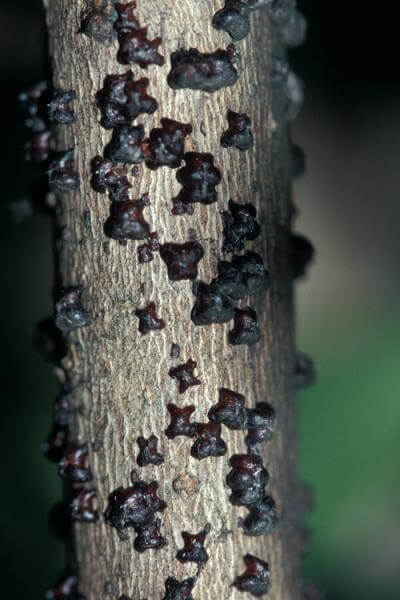
Lobate lac scale is a scale insect, native to India and Sri Lanka, that was identified in the Bahamas in 1992. In the U.S., the scale was first identified in Davie, Florida (Broward Co.) in August 1999 on an ornamental hibiscus (Hibiscus rosa-sinensis), which was subsequently destroyed. In 2000, the scale was again found in Broward and Miami-Dade counties on cocoplum (Chrysobalanus icaco) and Benjamin fig trees (Ficus benjamina). By 2001, the scale was in Palm Beach County and has continued to spread, rapidly becoming a major invader in southwest Florida.
Lobate lac scale is a wingless crawler, but can be carried on air currents and animals (e.g. birds) to new host plants. It primarily attacks woody dicots, forming a dark crust over twigs when at high densities. By 2003, it had been documented to attack 94 of 155 native south Florida woody plant species and roughly the same number of horticultural/agricultural non-native species (over 44 families). Plants can be killed by high density infestations. Some of the most common natives in south Florida (wax myrtle–Myrica cerifera, cocoplum–C. icaco, myrsine–Myrsine guianensis) are being impacted in the private landscape and in conservation areas (Everglades National Park, Loxahatchee National Wildlife Refuge, etc.). Probably the greatest threat of lobate lac scale spread beyond Florida is to the greater Caribbean, California, and Hawaii on shipments of ornamental or agricultural plants.
Eleven of the 28 families of Coccoidea scale insects are represented in the native Florida fauna. However, the lac scale family (Kerriidae) is a group of mainly tropical species not native to the USA. (A few species occur in low latitude deserts in the USA.) More native lac scale species are found in Mexico and South America.
Chemical treatment can protect landscape and agricultural plants, but biological control is the most likely management approach for natural areas. USDA ARS is currently evaluating two potential biological control species from India and Thailand.
USFS scientists and managers developed a conservation priority-setting framework for forest tree species at risk from pest & pathogens and other threats. The Project CAPTURE (Conservation Assessment and Prioritization of Forest Trees Under Risk of Extirpation) uses FIA data and expert opinion to group tree species under threat by non-native pests into vulnerability classes and specify appropriate management and conservation strategies. The scientists prioritized 419 tree species native to the North American continent. The analysis identified 15 taxonomic groups requiring the most immediate conservation intervention because of the tree species’ exposure to an extrinsic threat, their sensitivity to the threat, and their ability to adapt to it. Each of these 15 most vulnerable species, and several additional species, should be the focus of both a comprehensive gene conservation program and a genetic resistance screening and development effort. Lobate lac scale is not known to be a threat to any of these 15 most vulnerable species.
Sources
Howard, F.W., Pemberton, R., Hamon, A., Hodges, G.S., Steinberg, B., Mannion, C.M., McLean, D., Wofford, J. 2004. Featured Creatures: lobate lac scale. https://creatures.ifas.ufl.edu/orn/scales/lobate_lac.htm
Potter, K.M., Escanferla, M.E., Jetton, R.M., Man, G., Crane, B.S., Prioritizing the conservation needs of US tree spp: Evaluating vulnerability to forest insect and disease threats, Global Ecology and Conservation (2019), doi: https://doi.org/10.1016/



